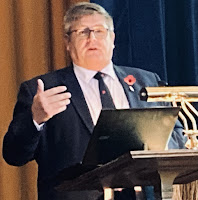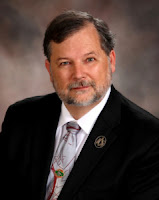Wow! That was one busy weekend!
Actually, I guess it was only the twenty-six or so hours between Friday and Saturday nights, but there were three meetings packed in there.
Scott Council 1 of New Jersey’s Cryptic Rite hosted its Annual Assembly Friday. Not just elections and installation of officers, but a palpable “do or die” night. The grand master wanted to see the officers were proficient in the Opening, Closing, and the NPD form of balloting. Hardly unreasonable, but the atmospheric tension changed a deservedly festive evening into something ruinously uncomfortable.
Had this been my first meeting in Freemasonry, I wouldn’t be back for another. It was like Dean Wormer at Delta House cashing in the Double-Secret Probation. Except we knew it was coming.
The grand master has had the goal of reducing the Grand Council from ten subordinate councils to four. I don’t believe he was elected for that purpose. I’m not aware that he made this a campaign promise. I do know this goal has not been revealed to the membership at large, but only to the hundred or so guys who keep everything afloat statewide. Basically, if you didn’t attend Grand Council’s Annual Assembly in March, and if you’re not among the few who heed the Silver Trumpet, as it were, in your local council, then I doubt you’d have firsthand knowledge of the plans to reorganize the Cryptic Rite in New Jersey thusly.
On our end at Scott Council, we were presented a Hobson’s choice: We would merge with a council twenty-two miles away in an arrangement that would rob us of meeting place, meeting schedule, our money (I suspect that was key in all this), and our name.
The upside? I don’t know. Gaining the wisdom that comes from being burned?
The plan was written in ink before we knew what was happening. No negotiation. No common ground. Just a “join or die” sales pitch that would have created a new council to be another division in the Atlas-Pythagoras Corporation. A perfect deal for them, but we weren’t getting anything out of it—and did I mention we never asked for any of this, that eliminating Scott Council would have doomed Scott Chapter, the Royal Arch chapter with whom we’ve been conjoined since 1860?
I could go on and itemize the various nefarious components of that entire process, but I’m determined to remain positive.
In truth, Scott Council did have one option: to vote down the obnoxious merger scheme, and that’s what we did, to persevere into the future, which is what we’re doing.
Congratulations to T.I.M. Frank, for steering us into the safe harbor of the end of the year, and to new T.I.M. Rob for organizing the team that will see us through the ensuing Anno Depositionis. Everyone did a strong enough job with the ritual to stave off the all-but-threatened arrest of our warrant (ergo the uneasiness in the room), and we’ll have to improve on everything moving forward.
I felt much better the next morning, even though I had to trek all the way back to the same place where my council met twelve hours earlier. It was time for the Biannual Meeting of New Jersey Lodge of Masonic Research and Education 1786! Elections/installation, etc.
 |
| Josh Barnett photo |
Cheers to Worshipful Master Marty, who led us through a time blemished by the pandemic; to Matt, who served in the South, but now must take leave for personal reasons; and to Mike, who helmed the secretary’s desk. Our new Master is Craig, who was installed by Grand Master David Tucker, himself a Past Master of our research lodge.
Upon receiving the gavel of authority, Craig installed his own officers, something I haven’t seen done since Marco’s day.
Exhibiting the wisdom of Solomon, Craig is letting his veterans do their thing. Matt has planned our visit to Princeton Lodge 38 for January 23, where he and Howard and Scott will show our hosts what a research lodge is all about. I am working on another visit for February, which I’ll tell you all about if it comes together. And I’m arranging an utterly mind-roasting day of Masonic culture for June. Bob is expanding on his John Skene Day for August. Don remains in the West, where he schedules the presenters at our Regular Communications. It’s going to be a great year.
While most present in the room had to race to other installations around the state, about a dozen of us adjourned to the steakhouse around the corner for one hell of a hearty meal.
“May I have a Guinness?” I said at the drinks order. “Small or large?” the young waiter countered. Accustomed to the universal measurement of the pint, I was vexed. “Large, please,” said I, like a confident blackjack player. It took almost thirty minutes, but the kid lurches toward me heaving a glass grail containing what must have been forty or more ounces of the malty medicant. Everyone looked at me like an intervention might be forthcoming.
I was careful to match it with a lot of food, and I downed every drop in an hour. It made no effect on my sobriety; I don’t know if that’s a good thing or a bad thing. No, it must have been good because we were back in the car and Byron navigated us to Don Francisco Cigars, a smoking oasis apparently very popular with local Masons.
Seated in the back were half a dozen hailing from the several lodges in the area. I enjoyed an El Rey del Mundo (that’s the Honduran El Rey) Robusto Larga—the first time I’ve smoked one of those since I worked for Lew Rothman fifteen years ago. It was great. A little on the dry side, but still a pleasure. They could use ventilation in that place.
After a few hours it was back on the road because my AMD council was holding—that’s right—its installation of officers. I was still stuffed from the steakhouse so I skipped dinner, but Chef Andy served a three-course meal of soup, kielbasa with kraut, and a baked ham the size of a Buick small block. I had fun watching everyone eat while I scrolled through the research lodge installation photos on Facebook.
With both our master and our secretary out sick, Bill saved the night by having printed copies of the ritual in hand. (Come to think of it, he handled our council installation the night before.) There were about twelve of us for the meeting, of whom almost everyone had to exit for the qualification, but it went without a glitch and V. Bro. Nick is the new Master of J. William Gronning Council 83. Huzzah!
I’m done and extremely ready for bed. After driving about 250 miles in the past day, I’m less than three miles from home when I pass some local cop eying the traffic for whoever he can nab. He likes me, naturally. Pulls me over with his George Lucas light show and, with the face of a fifteen-year-old, informs me the light at my rear license plate is out.
I didn’t even know I had a license plate light, so I said to him “I didn’t even know I had a license plate light.”
“Pretty reasonable, if you think about it,” I helpfully added, “because it doesn’t work.” With too much passion in his voice, he also said he thought my car registration had expired. “No sir,” I said, producing the document as a card sharp might flip over the ace of spades to cinch the blackjack hand. He let me go “with a warning.” Twerp.
































































































































